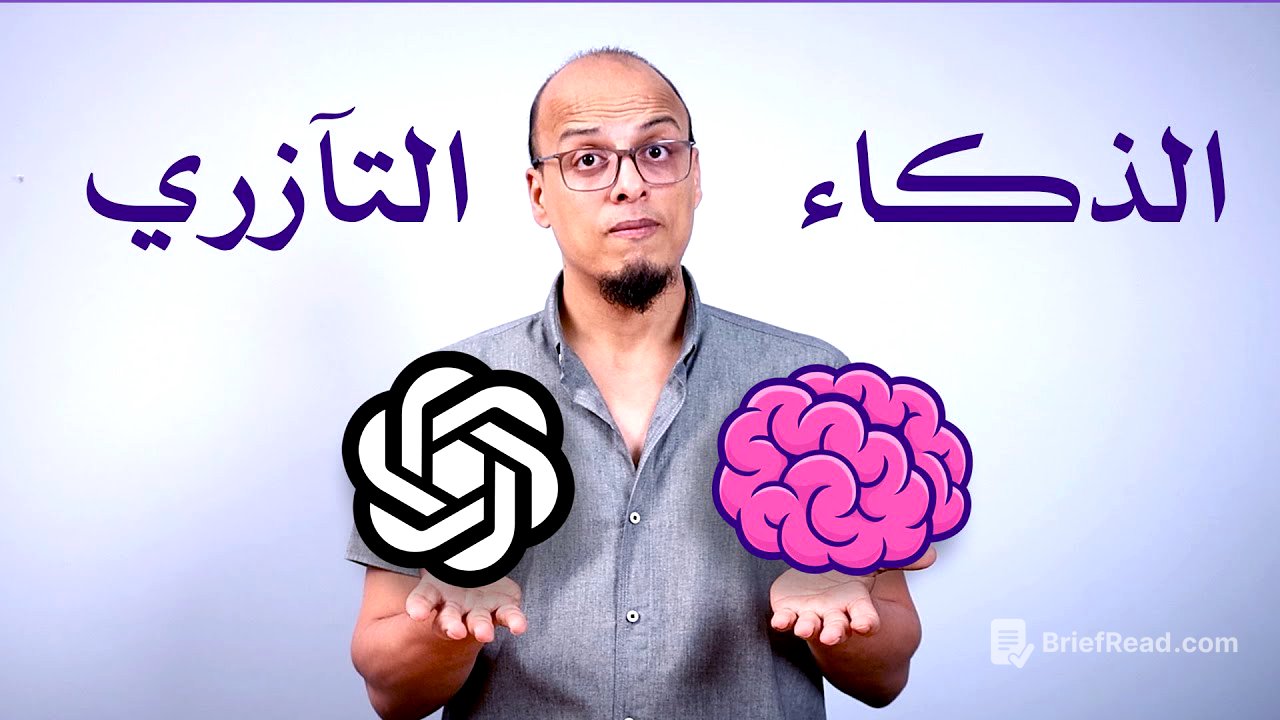TLDR;
This video summarises the book "Co-Intelligence", exploring how to integrate AI into our lives and work. It emphasises using AI as a tool to enhance human capabilities rather than replace them, and provides practical advice on leveraging AI for creativity, learning, and personal growth. The video also warns against emotional dependency on AI and highlights the importance of maintaining a critical perspective.
- AI should be used to enhance, not replace, human skills.
- Experiment with AI in various aspects of life to understand its capabilities and limitations.
- Define clear roles for AI to improve the quality of its output.
- Be cautious of emotional dependency on AI.
- Use AI to stimulate creativity and generate new ideas.
- AI can be a valuable tool for learning and personal development.
مقدمة وتعريف بالكتاب [0:00]
The video introduces the book "Co-Intelligence," which explores the collaborative relationship between artificial and human intelligence. It addresses concerns about AI replacing human intelligence, advocating instead for a synergy between the two. The book provides guidance on using AI tools to improve various aspects of life and work. The presenter notes that the advice given is designed to be timeless, remaining relevant despite the rapid development of AI models. He also mentions that he will be adding his own insights and tips to enhance the book's content.
نصائح عامة [4:00]
The video transitions into a discussion of general advice for using AI effectively. It stresses the importance of understanding these tips before integrating AI into problem-solving or productivity enhancement.
استخدم الـ AI كحذاء جري وليس كعكاز [4:10]
The first key piece of advice is to use AI as a "running shoe," not a "crutch." This means AI should enhance our abilities, not replace them. Over-reliance on AI can lead to laziness and skill atrophy. Instead, AI should free up our energy to focus on tasks that AI cannot improve, leading to better overall results and making us less likely to be replaced in the workforce. The presenter gives examples of jobs that have already been replaced by AI, such as social media content creation, and emphasises that the solution is to produce work of a higher quality than AI can easily replicate.
استخدم الـ AI في كل شيء! [6:06]
The second piece of advice is to experiment with AI in all aspects of your life. Unlike traditional computer programs, AI language models don't have a clear user manual, so experimentation is crucial. By exploring different applications, you can discover how AI can assist you and also identify its limitations. This knowledge helps you focus your energy on tasks that AI cannot handle, increasing your chances of excelling and making you harder to replace.
حدد له دور واضح من البداية [6:54]
The third piece of advice is to define a clear role for the AI from the beginning of your interaction, essentially assigning it a profession or persona. For example, when seeking help with planning, instruct the AI to act as a personal success planning expert. This context improves the relevance and quality of the AI's responses. However, it's important to remember that you are communicating with a machine, not a human. Avoid treating AI as a person with emotions or expecting it to understand you empathetically.
تحذير.. الــ AI والفراغ العاطفي! [8:50]
The video warns against the dangerous illusion of treating AI as a human, particularly due to widespread psychological fragility and emotional emptiness. The presenter notes that many young people suffer from emotional void, exacerbated by romanticised media portrayals. This can lead to unhealthy attachments to AI, similar to attachments to fictional characters. It's crucial to remember that you are interacting with an inanimate object, and AI is not a substitute for human connection. Companies may exploit this tendency for profit, so caution is advised.
استخدام الــ AI كمحفز للإبداع [10:50]
The video transitions to practical tips for using AI to enhance creativity. AI is excellent at generating numerous ideas quickly, but human input is still needed to inject creativity. View AI as a tool to stimulate your own creative process, not as a source of effortless creative ideas. If you rely solely on AI for traditional ideas, you risk becoming redundant. AI's strength lies in providing the initial spark, helping you overcome the difficulty of finding a starting point.
دمج الأفكار [11:58]
The first method for using AI as a catalyst for creativity is to integrate ideas. AI excels at repeating and combining patterns to produce new outputs. To leverage this, ask AI to combine two seemingly unrelated concepts to generate unique and creative ideas. For example, instead of asking for profitable project ideas based on a love of reading, ask for ideas that combine a love of reading with a love of food.
توليد الكثير من الأفكار [13:10]
The second method is to generate many ideas and then filter them. AI doesn't tire of generating numerous ideas, so ask it for 10, 20, or even 100 ideas. While many will be repetitive, you can then focus on the unique ones. Take a promising idea and ask AI to generate three to five variations or scenarios. Continue filtering and refining until you find an idea you want to develop further. Even if you don't arrive at a final idea, the process can stimulate your mind and lead to creative breakthroughs later on.
تنوع الأساليب [15:00]
The third method is to diversify approaches to stimulate creativity. Experiment with different styles and methods to achieve your desired outcome. For text-based results, ask AI to rewrite your text in different styles, such as literary, poetic, or humorous. While AI may struggle with humour, it can guide you towards modifications you can make yourself. For image generation, explore different artistic styles, noting that many style names are in English. The presenter recommends a video that showcases various image styles and will include a link in the video description. Using English prompts often yields better results due to the language's prevalence in AI training data.
استخدام الـ AI كمساعد شخصي [17:44]
The video discusses using AI as a personal assistant. AI can assist with various professional tasks, acting as a permanent personal assistant.
استكشف حدود إمكانياته [18:00]
The first step is to explore the limits of AI's capabilities in relation to your work. Some tasks AI can perform well, while others it will fail at. Try AI on all your work tasks to understand the difference. For tasks where AI fails, try breaking them down into smaller tasks and seeking AI's assistance with those. Even if AI fails, revisit these tasks after a few months as AI models improve.
بناء تصور لـ 3 أنواع من المهام [14:38]
It's important to identify three types of tasks: those AI can do entirely on its own, those where AI can assist you, and those you must do completely on your own. Tasks AI can do entirely include reorganising data in Excel or extracting data into a new file. Tasks where AI can assist include writing and organising ideas, where you provide the main points and AI writes the full text. Tasks you must do yourself will vary depending on your work. Always review the results from AI to ensure accuracy and quality. Over-trusting AI can lead to problems. Reviewing AI's output also helps you learn and develop your skills.
استخدام الــ AI كمعلم [20:35]
The video explores using AI as a teacher, which can be highly beneficial.
شرح المفاهيم المعقدة [20:52]
One way to use AI as a teacher is to explain complex concepts. If you encounter a difficult concept in a book or course, AI can simplify it for you. Ask AI to explain the concept as a passionate teacher who simplifies ideas, or to explain it in terms a 10-year-old could understand. You can ask follow-up questions to clarify any unclear points. AI doesn't tire of repetition or simplification, unlike a human teacher. However, avoid using AI to explain religious concepts or interpret verses, as AI matches patterns and data and may incorporate secular ideas.
تصميم خطة تعلم [22:30]
Another way to use AI for learning is to design a learning plan. AI can act as an expert in creating a learning plan for a specific skill or field, tailored to your abilities. Tell AI the skill you want to learn, your current level, the time you can allocate, and any other important details. If you're unsure of the important details, ask AI what information it needs to create the best plan. The resulting plan is a guideline that you can modify as needed.
اجعله يختبرك [23:16]
AI can also test you on the material you're learning. If you have the material in text form, provide it to AI and ask it to test you on the content. You can ask for multiple-choice questions or short-answer questions. AI can correct your answers question by question or provide a final grade. It can also explain your mistakes. This interactive approach can be more effective than traditional study methods. You can even ask AI to encourage and congratulate you on correct answers.
ممارسة فعلية لبعض المهارات [24:00]
For skills like negotiation or language learning, you can practice by speaking with AI. Ask AI to suggest a scenario for you to practice your negotiation skills. AI can analyse your responses, point out strengths and weaknesses, and suggest improvements. With each new scenario, your negotiation skills will gradually improve.
رفيق قراءة [24:35]
AI can be used as a reading companion. For a specific book, discuss each chapter with AI after you read it. Tell AI what you liked and disliked about the chapter, and ask it to explain anything you didn't understand. For the best results, provide AI with the text of the book in a text file.
التلخيص [25:28]
AI can summarise books, chapters, articles, research papers, or other text content. Provide AI with the text content you want summarised. Do not rely on AI to access the content via the internet. The presenter shares his experience of asking AI to summarise a podcast episode by providing a link. The AI produced a summary unrelated to the episode's content, as it only used the title and description. For summarising videos, use a browser add-on to extract the text from the video and then provide that text to AI.
استخدام الــ AI كمرشد وموجه [27:14]
The video discusses using AI as a guide and mentor, or coach. While AI can act as a teacher by explaining concepts, a coach guides you to find solutions to your problems yourself.
طبق مع نموذج GROW [27:55]
You can apply the GROW model (Goal, Reality, Options, Will) to AI coaching. GROW helps you define a clear goal, assess your current reality, explore options and solutions, and commit to the agreed-upon steps. Instruct AI to act as an expert coach in your area of interest, providing rational and practical guidance while also considering the psychological aspect. Ask AI to pose questions to help you find the best advice.
المساعدة في اتخاذ قرار [29:04]
AI can assist with making decisions. Ask AI to act as an expert in making difficult decisions related to your field. Provide all the details relevant to the decision and ask AI to pose important questions to increase your clarity. After you feel inclined towards a specific decision, ask AI to critique it, requiring you to defend your choice. This process helps you determine if it's the right decision. The presenter mentions a free course on decision-making available on the channel.
التعامل مع الفشل [30:06]
AI can help you deal with failure. If you've experienced a failure and are struggling to recover, AI can act as a coach to help you move forward. Instruct AI to act as an expert coach in the field where you failed, with the ability to help others overcome failure and learn from it positively. Ask AI to pose important questions to understand the situation and provide advice to help you overcome the failure and learn from the experience without self-deception.
خاتمة عن الــ AI والمستقبل [31:15]
The video concludes by discussing the future of AI and its impact on our lives. New technologies often create chaos initially, with uncertainty and conflicting expectations. Even the companies developing AI technologies don't know exactly where the world is headed. While AI has the potential to change the world, it may not be in the ways currently imagined. The presenter refers viewers to a podcast episode on the history of AI for a more detailed discussion of future expectations. The video emphasises the importance of focusing on practical advice and how AI can benefit our lives and work.









